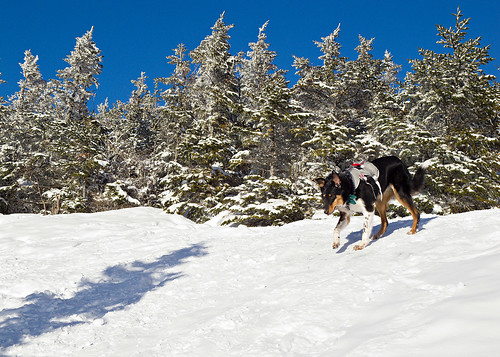 |
| Colvin, wearing a Ruff Wear Doubleback harness, descending Cascade Mountain |
Wow, it didn’t occur to me till today that Colvin Harrison had never summited a 46-R. Now don’t think he’s been neglected, it’s not like he hasn’t been up two of the highest peaks in New Hampshire and a (sub) summit of Vermont’s highest peak in the first 9 months he was with us, just none of the Adirondack high peaks from whom his namesake surveyed the Adirondacks over 130 years ago.
So we picked a day when the wind chills were hovering in the -27F (-32C) range, and the ambient temps at or below 0 on the summit for Colvin to summit his first two Adirondack high peaks! Despite the cold, it was actually a beautiful sunny day with perfect snow conditions.
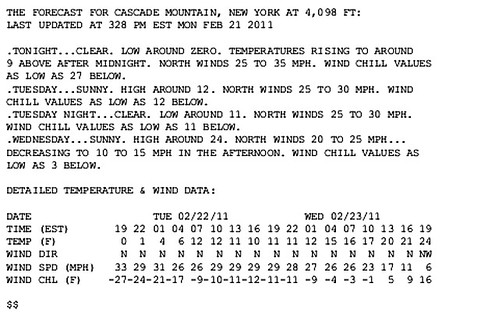 |
| This forecast data is from an experimental NWS weather forecaster out of Burlington, VT. Unfortunately I didn't get a screen shot before we started hiking. Still, winds were forecast in the 30s mph all day, and it actually was trending warmer as the evening progressed. Conditions at 5pm were at least as bad as 7pm. |
If you have occasionally read this blog, you know I despise the Adirondack High Peaks Wilderness with a passion. That sounds bloody awful, perhaps I should explain (again). I hate the crowds, rules and fees of the Adirondack High Peaks Wilderness, which just happens to be home of the bulk of the high peaks. While I summited several ADK high peaks in the weeks preceding and subsequent to Colvin Harrison’s arrival in New York, he just wasn’t trail ready till late March of 2010.
Unfortunately, because I was k9less during that time, I was able to use different access points than normal for all the high peaks I summited. The peaks that were in the HPW I reached via the Adirondack Mountain Reserve which is privately owned but accessible to humans (no dogs) via easements. This approach, while not a solitary endeavor, is usually less used than the other access points.
Then the spring came, and mud season with it. We had planned for him to hike the Colvin Range last spring, but it got pushed off by bad weather, and eventually by paddling season that is a necessary escape from the summer heat and humidity.
So oddly, it was 53 weeks before Colvin reached the summit of his first Adirondack high peak. Originally the Upper and Lower Wolfjaws were planned for various reasons, including solitude and the irony of a dogs first 46-R being the “wolfjaws”, but the closer parking area being unploughed and not wanting to walk in the road (almost no shoulder during the winter with the snow banks) while trucks and cars whizzed by at 55mph, I aborted the Wolfjaws via Deer Brook. And damn the cliche, decided to climb Cascade and Porter, two of the Adirondacks easiest high peaks and often an aspiring 46-Rs first ticks on a checklist.
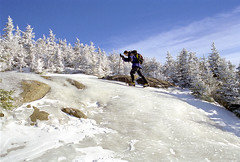 |
| Aim ascending Cascade (Jan 2005) |
We arrived at the Cascade/Pitchoff trail head to find it packed. Cascade and Giant Mountain are probably the two most hiked high peaks in the Adirondacks, and on any weekend day you will find both trail heads packed with cars. So I drove towards Lake Placid and stopped at the Cascade ski shop, then we drove up Mountain Road to check out the conditions on the Jack Rabbit trail. Plenty of good quality snow despite the recent heat wave. When we got back to Cascade there were still too many people on the trail, so we took a little nap in the warm sun (yes, direct sun in a car is warm even when it’s around zero outside). 2 hours later the parking areas were thinning out, and we were off.
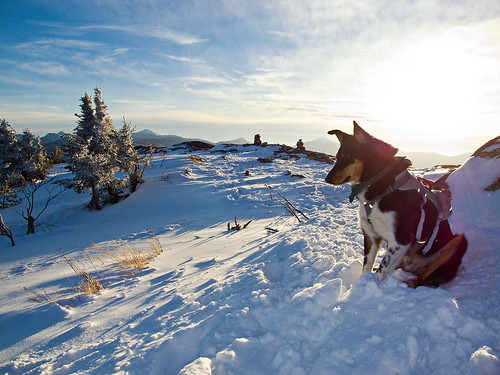 |
| Colvin at a wind break just below the summit. |
Obviously I was accepting I was going to be sharing the trail with people, unlike the desolate Wolfjaws via Route 73. However, while I was ok with making a deal with the Devil to get a good hike in on a pristine day. I didn’t want to be ascending during an exodus of hikers. Killing a few hours so I could catch the late afternoon light from the summits and only see a few people on the trail was easy enough. If timed just right I wouldn’t even need to use my headlamp. Very rarely are conditions this clear in the Adirondacks, and Cascade is a mountain that lives up to it’s record summit attempts. You can see 30 of 46 high peaks from it’s completely unbstructed summit and the best time to do so is in the early morning or late afternoon when the mountains really stand out with some depth.
Aside from that, I’ve always hiked Cascade either before sunrise or on a weekday. So despite the throngs of hikers that ascend it during peak days, I’ve pretty much always had the upper mountain to myself. Yep, I’ve only seen 2 other people on the summit of Cascade ever!
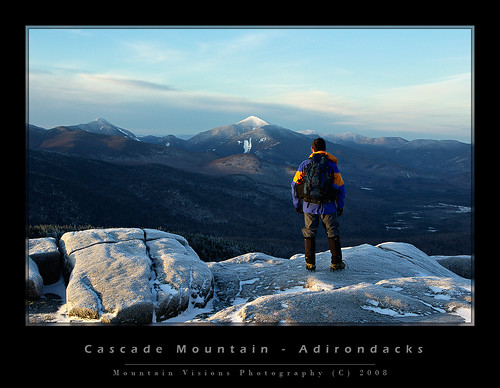 |
| The photographer taking in the early morning light, alone on one of the Adirondacks most hiked peaks (January 2008) |
If I had any doubts about the conditions on the summit, I didn’t need verbal verification. The last group of hikers we saw descending were dressed like they were on a winter ascent of Denali, one of the coldest major summits on earth.
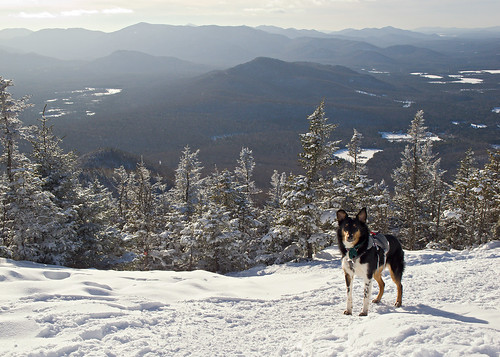 |
| Colvin below the summit |
Colvin and I were on the summit of Cascade in about 2 hours which wasn’t bad considering I had to attempt a field repair of a rivet on my MSR Denali. Messing with bolts, washers and nuts in 0F temps is pretty much futile unless it’s life and death -as I write this, it just occurred to me that in 2003 I had a crampon malfunction on Cascade as well. Eventually I gave up, I ditched the snowshoes below the summit of Cascade.
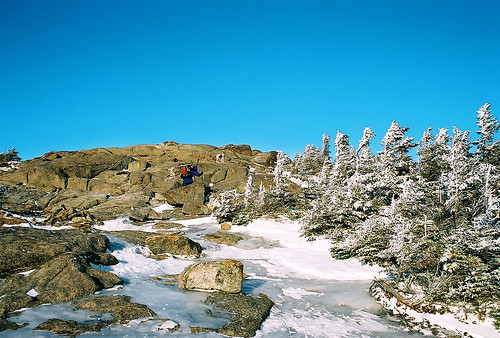 |
| Ascent up the summit slabs (January 2005). |
The climb up the summit slabs of Cascade was mostly bare rock with some avoidable ice, only one or two spots would crampons have made things safer, naturally I fell in one of those spots (the safer of the two, and the spot I fully expected to go down) on descent, otherwise bare booted to the summit over the rock, snow and ice without incident.
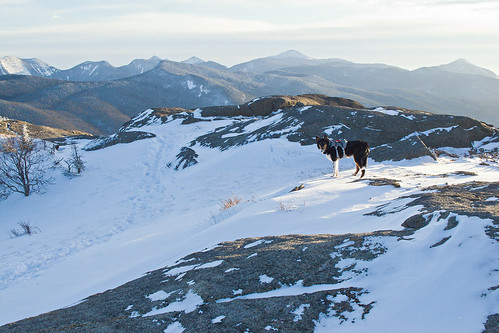 | ||||||||
| Colvin just feet below the summit as we began our descent. |
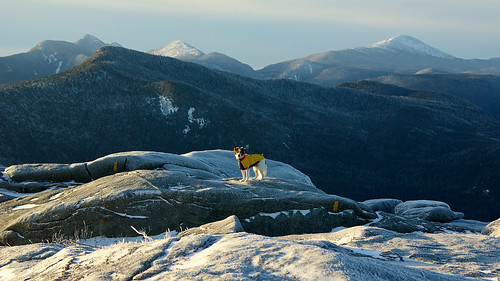 |
| Caney a few feet ahead of Colvin (January 2008 sunrise) 50mm vs about 105mm, side lit vs. backlit background. Notice the difference in compression and dimension with the telephoto vs the normal lens and the different lighting? |
Colvin did great. There was a section I thought he might have problems with, and the wind has never been his favorite force of nature. But he shot up the last .3 of a mile almost effortlessly picking the marked route perfectly unless he saw a better route. I didn’t have to give him an assist or verbal cues up or down. He’s getting much better on the trail and much more confident.
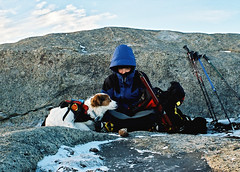 |
| Another cold winter day on Cascade (Jan 2004) |
We made quick time to Porter as we tried to warm up. The 1.4 miles round trip took about 30 minutes. We were back at the Cascade intersection by 5:30pm. The 2 mile descent took about 45 minutes sans snowshoes with only a few butt glissades where my bare boots met an icy patch as I jogged down hill. Colvin would see me jogging and sprint ahead full blast, come to a skidding stop in the snow and sprint back up the trail as I continued jogging down. As is typical, he generally hikes/sprints at least 50% more miles than the actual hike requires.
We were back at the car by 6:15p with just enough light to not need the headlamp.
Total stats for the hike. 2 ADK high peaks, 4600 ft gain/loss over 6.2 miles in 3 hours 30 minutes. Winds 30mph from the North, 0F ambient, and unlimited visibility. Pretty much a perfect mid winter day!!!










